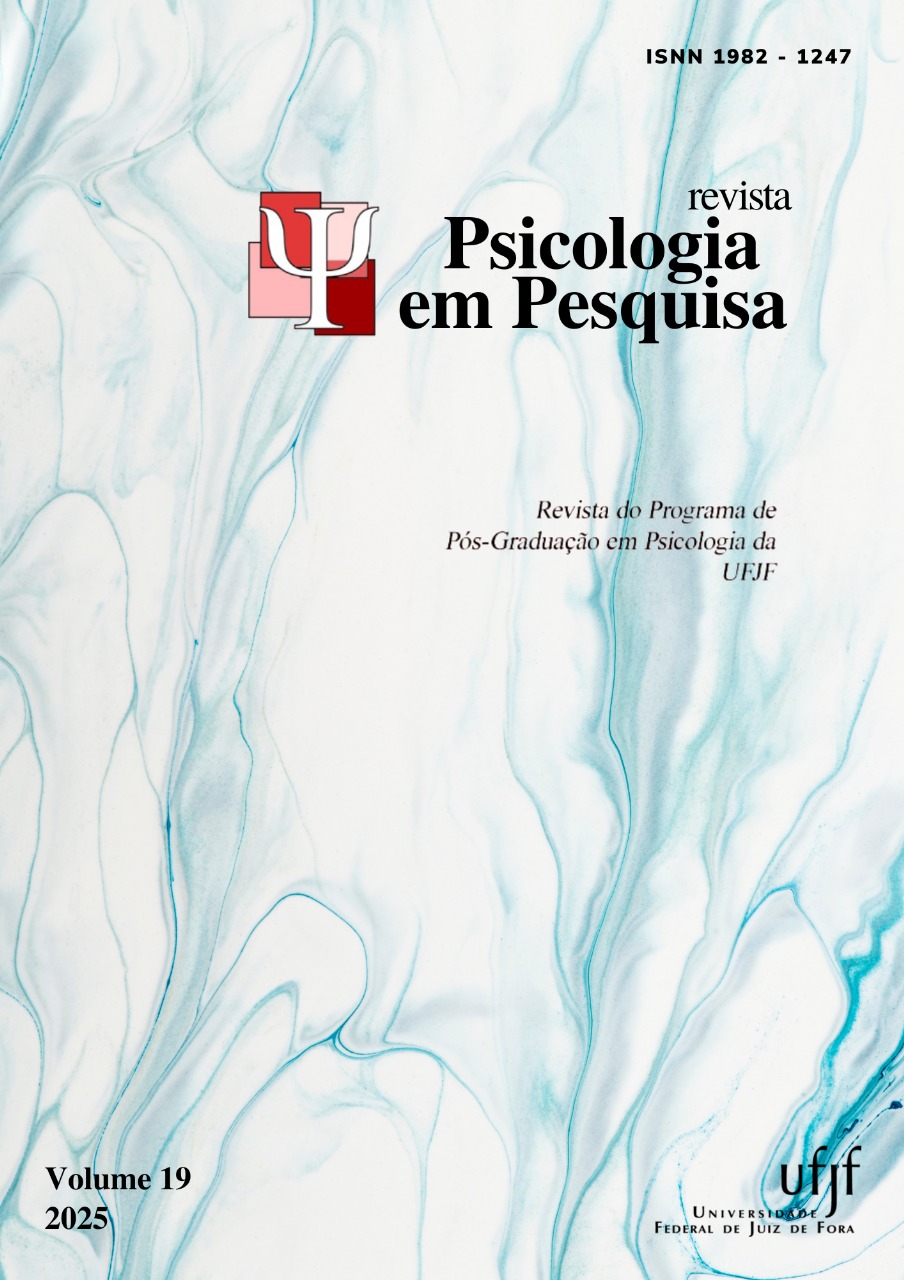Family climate in scientific productions and its influence on adolescent development
DOI:
https://doi.org/10.34019/1982-1247.2025.v19.39420Keywords:
Family Environment; Adolescence; Family RelationshipsAbstract
The present study aimed to map the scientific productions on family environment and/or climate and its influence on adolescent development. This is a systematic literature review of publications between 2012 and 2022. The descriptors used were: "family environment" OR "family climate" AND adolesc*. After selection, 18 articles remained as a sample. The results pointed to different theoretical conceptions of climate/family environment that supported the studies. In general, climate is associated with variables that promote protective or risky development in adolescence. Among the methodological characteristics, only two studies used a Brazilian instrument.
Downloads
References
Benetti, S. P. C, Pizetta, A., Schwartz, C. B., Hass, R. A., & Melo, V. L. (2010). Problemas de saúde mental na adolescência: características familiares, eventos traumáticos e violência. Psico-USF, 15(3), 321-332. https://doi.org/10.1590/S1413-82712010000300006
Bolsoni-Silva, A. T., & Del Prette, A. (2003). Problemas de comportamento: um panorama da área. Revista Brasileira de Terapia Comportamental e Cognitiva, 5(2), 91-103. http://pepsic.bvsalud.org/scielo.php?script=sci_arttext&pid=S1517-55452003000200002
Costa, B. A., & Zoltowiski, A. P. C. (2014). Como escrever um artigo de revisão sistemática. IN: S. H Koller, M. C. P. P., Couto, & J. V Hohendorff, (Eds.). Manual de Produção Científica. (pp. 39-54). Penso.
Crandall, A., Ghazarian, S. R., Day, R. D., & Riley, A. W. (2016). Maternal emotion regulation and adolescent behaviors: The mediating role of family functioning and parenting. Journal of youth and adolescence, 45(11), 2321-2335. http://dx.doi.org/10.1007/s10964-015-0400-3
Creswell, J. W. (2010). Projeto de pesquisa: métodos qualitativo, quantitativo e Misto. (3ª Ed.). Artmed.
Diener, E. (2005). Guidelines for national indicators of subjective well being and ill being. USA: University of Illinois.
Fosco, G. M., & Ryzin, M. V. (2016). Trajectories of Adolescent Hostile-Aggressive Behavior and Family Climate: Longitudinal Implications for Young Adult Romantic Relationship Competence. Developmental Psychology, 52(7), 1139– 1150. https://doi.org/10.1037%2Fdev0000135
Freitas, P. M. D., Costa, R. S. N., Rodrigues, M. S., Ortiz, B. R. D. A., & Santos, J. C. D. (2020). Influencia de las relaciones familiares sobre la salud y el estado emocional de los adolescentes. Revista Psicologia e Saúde, 12(4), 95-109. http://dx.doi.org/10.20435/pssa.vi.1065
Freire, T., & Tavares, D. (2011). Influência da autoestima, da regulação emocional e do gênero no bem-estar subjetivo e psicológico de adolescentes. Archives of Clinical Psychiatry (São Paulo), 38, 184-188. https://doi.org/10.1590/S0101-60832011000500003
Leme, V. B. R., Del Prette, Z. A. P., Koller, S. H., & Del Prette, A. (2016). Habilidades sociais e o modelo bioecológico do desenvolvimento humano: análise e perspectivas. Psicologia & Sociedade, 28(1), 181-193. https://doi.org/10.1590/1807-03102015aop001
Leusin, J. F., Petrucci, G. W., & Borsa, J. C. (2018). Clima Familiar e os problemas emocionais e comportamentais na infância. Revista da SPAGESP, 19(1), 49-61. https://dialnet.unirioja.es/servlet/articulo?codigo=6598253
Marturano, E. M., & Elias, L. C. S. (2016). Família, dificuldades no aprendizado e problemas de comportamento em escolares. Educar em Revista, 59, 123-139. https://www.scielo.br/j/er/a/hZc8jnYNJDsW9tFMP3tbBjd/?lang=pt&format=pdf
Moss, R., & Trickett, E. (1974). Classroom environment scale manual. Palo Alto: Consulting Psychologists Press.
Ouzzani, M., Hammady, H., Fedorowicz, Z., & Elmagarmid, A. (2016). Rayyan—a web and mobile app for systematic reviews. Systematic reviews, 5(1), 210. https://doi.org/10.1186/s13643-016-0384-4
Prado, D. (2017). O que é família. Brasiliense.
Prioste, A., Tavares, P., Silva, C. S., & Magalhães, E. (2020). The relationship between family climate and identity development processes: the moderating role of developmental stages and outcomes. Journal of Child and Family Studies, 29(6), 1525-1536. https://doi.org/10.1007/s10826-019-01600-8
Sá, D. G., Bordin, I. A., Martin, D., & Paula, C. S. de. (2010). Fatores de risco para problemas de saúde mental na infância/adolescência. Psicologia: Teoria e Pesquisa, 26(4), 643 -652. https://www.scielo.br/j/ptp/a/78wsJTFcrpKzwCPJCwQbs3H/?lang=pt&format=html
Silva, C. R., & Kaulfuss, M. A. (2020). A importância da família na educação infantil. Revista científica eletrônica de ciências aplicadas da FAIT. 1-10. http://www.fait.revista.inf.br/imagens_arquivos/arquivos_destaque/NWgq2JCop9F9YwD_2017-1-21-11-14-37.pdf
Schultz, D., & Shaw, D. S. (2003). Boys' maladaptive social information processing, family emotional climate, and pathways to early conduct problems. Social Development, 12, 440-460. https://psycnet.apa.org/doi/10.1111/1467-9507.00242
Teodoro, M. L., Allgayer, M., & Land, B. (2009). Desenvolvimento e validade fatorial do Inventário do Clima Familiar (ICF) para adolescentes. Psicologia: teoria e prática, 11(3), 27-39. https://www.redalyc.org/pdf/1938/193814403004.pdf
Villalba, C., & Almeida-Monge, E. (2017). Clima social familiar y su influencia en la conducta violenta en los escolares. Revista ciência UNEMI, 10(25), 97-102. https://www.redalyc.org/journal/5826/582661258010/582661258010.pdf
Queiroz, A., Tori, R., & Nascimento, A. (2017). Realidade Virtual na Educação: Panorama das Pesquisas no Brasil. Brazilian Symposium on Computers in Education (Simpósio Brasileiro de Informática na Educação - SBIE), 28(1), 203. http://dx.doi.org/10.5753/cbie.sbie.2017.203
Vilela, T. R., Silva, R. S., Grandi, C. G., Rocha, M. M., & Figlie, N. B. (2016). Emotional and Behavioral Problems in Children Living With Addicted Family Members: Prevention Challenges in an Underprivileged Suburban Community. Paidéia, 26(64), 225-234. https://www.scielo.br/j/paideia/a/fXtCh9kSsZRFpBpX4KZ4sXk/?lang=en
World Health Organization – WHO. (2013). Adolescent health. https://www.who.int/health-topics/adolescent-health#tab=tab_1















